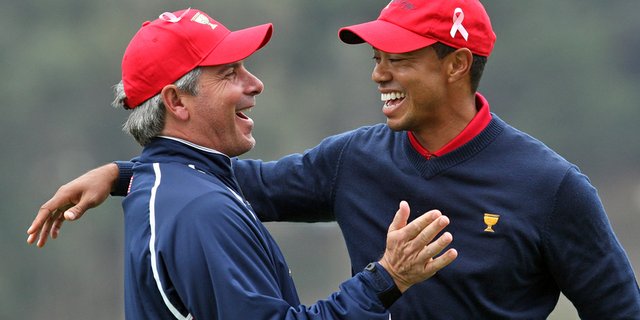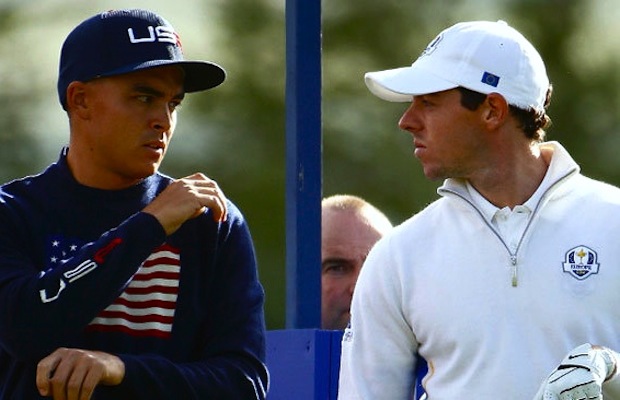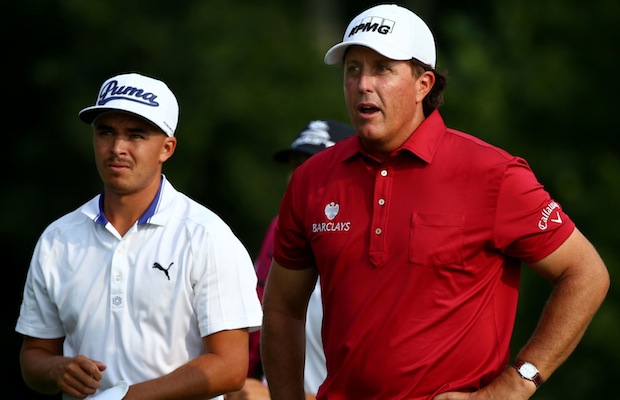Opinion & Analysis
Presidents Cup: What Couples can learn from DL3

By Jim Johnson
GolfWRX Contributor
It was an event filled with missed putts, near shanks and questionable captains picks. All of which left a bitter taste in the mouth of the defeated.
I’m talking about the U.S. Ryder Cup team, right? No, I’m talking about the 2011 Presidents Cup, where Robert Allenby was the questionable captain’s pick who couldn’t make a putt and Aaron Baddeley hit one of the worst shots in international team match history (until Webb Simpson’s hosel rocket at Medinah, that is).
U.S. Presidents Cup Captain Fred Couples seemed to ooze Seve Ballesteros charisma in 2011 at Royal Melbourne. Greg Norman, on the other hand, played the awkward Hal Sutton role to the hilt, cowboy hat, bad pairings and all.
Now that Medinah is a memory, albeit a bad one, at least American golf fans still have the Presidents Cup on U.S. Soil. But, if recent Ryder Cup history is any indication, American fans shouldn’t get too comfortable with being on top. Although the U.S. still leads the overall Ryder Cup by a margin of 25-12-2, they are 2-7 since 1995 and 7-9-1 since Europe joined Great Britain/Ireland in the biannual matches. With all the great players coming out of Asia, Australia and South Africa, it might be only a matter of time before American domination in the Presidents Cup comes to an end. In fact, the Presidents Cup could easily do a 180-degree turn in 2013 under Nick Price’s leadership. There has been much speculation that Couples will get the Ryder Cup job in 2014. But, if Couples isn’t careful, he just may be part of losing effort in 2013.
Here are four things Couples should have learned from 2012 U.S. Ryder Cup Captain Davis Love III at Medinah — things he should do to prevent a defeat at Muirfield Village by the International Team in 2013.
No. 1: Don’t back yourself into a corner before the start of Presidents Cup
As much as possible, Couples should keep an open mind going into the matches. He has to be open regarding how many matches each player will play and with whom. Love backed himself into a corner at Medinah, saying that no one on his team was going to play five matches. Doing this, he hamstrung himself on Saturday with the U.S. poised to deliver a knock out blow to the European team.
By resting Phil Mickelson and Keegan Bradley, Love took the crowd out of the matches and helped allow Europe to regain some momentum. If anything, Love was a bit too open about his approach prior to last Friday’s first matches. Couples would do well to keep things a bit closer to the vest. Some things belong in the team room, regardless how much those of us in the media would like otherwise.
No. 2: Stay with the hot hand
Couples needs to go with who is playing well. Of course, this includes his captain’s picks. But just as important, perhaps more so are those playing well during the event. It’s hard to fault American Ryder Cup captain Davis Love III for picking Brandt Snedeker, the FedExCup champ, and Dustin Johnson, Steve Stricker and Jim Furyk. But, one hopes that Couples will consider factors beyond simply experience and who Tiger wants to partner with (more on that later).
As Keegan Bradley proved, youthful energy can carry a team through a tough match and excite the crowd at the same time. Bradley, Johnson, Jason Dufner, Hunter Mahan and Simpson are all likely to make the team on points. But Couples better have young guns like Rickie Fowler and Bud Cauley on speed dial as well. As hard as it is, it may be time to turn the page on guys like Steve Stricker and Jim Furyk.
No. 3: Make sure your assistant captains are there to assist
It was pretty obvious on Sunday that No. 18 was playing shorter than the yardage. Yet, several American players in key matches hit shots that ended up long. Where were the assistant captains to give them that information?
Too often, assistants are viewed as potential Ryder Cup captains giving an audition. Couples needs to make sure that his assistants are engaged and giving needed information to the players, not positioning themselves for Seoul in 2015. Finally, enough with having celebrities like Michael Jordan lying on the tee box smoking cigars and wearing apparel promoting his brand. Sorry Bill Murray, this means you too.
No. 4: Tame Tiger
What should Couples do with Tiger? Davis tried sitting Tiger for the first time in history and it seemed to have zero impact on his play. He didn’t look any fresher Saturday afternoon than he did Friday afternoon. But, it did do two things. On the positive side, it removed a player from a format that didn’t mesh with his game. On the negative side, it absolutely forced him to sit Phil and Keegan.
There was no possibility that Tiger would sit and Phil would play all five matches. Another aspect of Tiger is figuring out who will be his partner. Like other captains, Love apparently allowed Tiger to pick his partner. On paper, Stricker was and has been a nice partner for Tiger, but they were no match for their opponents at Medinah, going 0-3. Couples had the right idea in 2011 when he paired Tiger with Dustin Johnson. He needs to use all of his considerable charisma to get Tiger to take players like Johnson under his wing in team play, on the golf course. Not only will that be good for American golf going forward, it may just allow Mr. Woods to have successful partnerships for future President Cup and Ryder Cup matches. This will take Tiger out of his comfort zone. But, maybe Tiger needs to be a bit uncomfortable out there, not Hal Sutton 2004 uncomfortable, but just enough to get him edgy and intense.
Perhaps, Couples will do some of these things or none of these things. What we do know is that Couples will be Couples… loose as a goose and having fun. It’s worked the last two Presidents Cup events. If it works again, maybe we’ll see him playing bagpipes and wearing a kilt in 2014. Are you listening PGA of America?
Opinion & Analysis
The 2 primary challenges golf equipment companies face

As the editor-in-chief of this website and an observer of the GolfWRX forums and other online golf equipment discourse for over a decade, I’m pretty well attuned to the grunts and grumbles of a significant portion of the golf equipment purchasing spectrum. And before you accuse me of lording above all in some digital ivory tower, I’d like to offer that I worked at golf courses (public and private) for years prior to picking up my pen, so I’m well-versed in the non-degenerate golf equipment consumers out there. I touched (green)grass (retail)!
Complaints about the ills of and related to the OEMs usually follow some version of: Product cycles are too short for real innovation, tour equipment isn’t the same as retail (which is largely not true, by the way), too much is invested in marketing and not enough in R&D, top staffer X hasn’t even put the new driver in play, so it’s obviously not superior to the previous generation, prices are too high, and on and on.
Without digging into the merits of any of these claims, which I believe are mostly red herrings, I’d like to bring into view of our rangefinder what I believe to be the two primary difficulties golf equipment companies face.
One: As Terry Koehler, back when he was the CEO of Ben Hogan, told me at the time of the Ft Worth irons launch, if you can’t regularly hit the golf ball in a coin-sized area in the middle of the face, there’s not a ton that iron technology can do for you. Now, this is less true now with respect to irons than when he said it, and is less and less true by degrees as the clubs get larger (utilities, fairways, hybrids, drivers), but there remains a great deal of golf equipment truth in that statement. Think about it — which is to say, in TL;DR fashion, get lessons from a qualified instructor who will teach you about the fundamentals of repeatable impact and how the golf swing works, not just offer band-aid fixes. If you can’t repeatably deliver the golf club to the golf ball in something resembling the manner it was designed for, how can you expect to be getting the most out of the club — put another way, the maximum value from your investment?
Similarly, game improvement equipment can only improve your game if you game it. In other words, get fit for the clubs you ought to be playing rather than filling the bag with the ones you wish you could hit or used to be able to hit. Of course, don’t do this if you don’t care about performance and just want to hit a forged blade while playing off an 18 handicap. That’s absolutely fine. There were plenty of members in clubs back in the day playing Hogan Apex or Mizuno MP-32 irons who had no business doing so from a ballstriking standpoint, but they enjoyed their look, feel, and complementary qualities to their Gatsby hats and cashmere sweaters. Do what brings you a measure of joy in this maddening game.
Now, the second issue. This is not a plea for non-conforming equipment; rather, it is a statement of fact. USGA/R&A limits on every facet of golf equipment are detrimental to golf equipment manufacturers. Sure, you know this, but do you think about it as it applies to almost every element of equipment? A 500cc driver would be inherently more forgiving than a 460cc, as one with a COR measurement in excess of 0.83. 50-inch shafts. Box grooves. And on and on.
Would fewer regulations be objectively bad for the game? Would this erode its soul? Fortunately, that’s beside the point of this exercise, which is merely to point out the facts. The fact, in this case, is that equipment restrictions and regulations are the slaughterbench of an abundance of innovation in the golf equipment space. Is this for the best? Well, now I’ve asked the question twice and might as well give a partial response, I guess my answer to that would be, “It depends on what type of golf you’re playing and who you’re playing it with.”
For my part, I don’t mind embarrassing myself with vintage blades and persimmons chasing after the quasi-spiritual elevation of a well-struck shot, but that’s just me. Plenty of folks don’t give a damn if their grooves are conforming. Plenty of folks think the folks in Liberty Corner ought to add a prison to the museum for such offences. And those are just a few of the considerations for the amateur game — which doesn’t get inside the gallery ropes of the pro game…
Different strokes in the game of golf, in my humble opinion.
Anyway, I believe equipment company engineers are genuinely trying to build better equipment year over year. The marketing departments are trying to find ways to make this equipment appeal to the broadest segment of the golf market possible. All of this against (1) the backdrop of — at least for now — firm product cycles. And golfers who, with their ~15 average handicap (men), for the most part, are not striping the golf ball like Tiger in his prime and seem to have less and less time year over year to practice and improve. (2) Regulations that massively restrict what they’re able to do…
That’s the landscape as I see it and the real headwinds for golf equipment companies. No doubt, there’s more I haven’t considered, but I think the previous is a better — and better faith — point of departure when formulating any serious commentary on the golf equipment world than some of the more cynical and conspiratorial takes I hear.
Agree? Disagree? Think I’m worthy of an Adam Hadwin-esque security guard tackle? Let me know in the comments.
@golfoncbs The infamous Adam Hadwin tackle ? #golf #fyp #canada #pgatour #adamhadwin ? Ghibli-style nostalgic waltz – MaSssuguMusic
Podcasts
Fore Love of Golf: Introducing a new club concept

Episode #16 brings us Cliff McKinney. Cliff is the founder of Old Charlie Golf Club, a new club, and concept, to be built in the Florida panhandle. The model is quite interesting and aims to make great, private golf more affordable. We hope you enjoy the show!
Opinion & Analysis
On Scottie Scheffler wondering ‘What’s the point of winning?’

Last week, I came across a reel from BBC Sport on Instagram featuring Scottie Scheffler speaking to the media ahead of The Open at Royal Portrush. In it, he shared that he often wonders what the point is of wanting to win tournaments so badly — especially when he knows, deep down, that it doesn’t lead to a truly fulfilling life.
View this post on Instagram
“Is it great to be able to win tournaments and to accomplish the things I have in the game of golf? Yeah, it brings tears to my eyes just to think about it because I’ve literally worked my entire life to be good at this sport,” Scheffler said. “To have that kind of sense of accomplishment, I think, is a pretty cool feeling. To get to live out your dreams is very special, but at the end of the day, I’m not out here to inspire the next generation of golfers. I’m not out here to inspire someone to be the best player in the world, because what’s the point?”
Ironically — or perhaps perfectly — he went on to win the claret jug.
That question — what’s the point of winning? — cuts straight to the heart of the human journey.
As someone who’s spent over two decades in the trenches of professional golf, and in deep study of the mental, emotional, and spiritual dimensions of the game, I see Scottie’s inner conflict as a sign of soul evolution in motion.
I came to golf late. I wasn’t a junior standout or college All-American. At 27, I left a steady corporate job to see if I could be on the PGA Tour starting as a 14-handicap, average-length hitter. Over the years, my journey has been defined less by trophies and more by the relentless effort to navigate the deeply inequitable and gated system of professional golf — an effort that ultimately turned inward and helped me evolve as both a golfer and a person.
One perspective that helped me make sense of this inner dissonance around competition and our culture’s tendency to overvalue winning is the idea of soul evolution.
The University of Virginia’s Division of Perceptual Studies has done extensive research on reincarnation, and Netflix’s Surviving Death (Episode 6) explores the topic, too. Whether you take it literally or metaphorically, the idea that we’re on a long arc of growth — from beginner to sage elder — offers a profound perspective.
If you accept the premise literally, then terms like “young soul” and “old soul” start to hold meaning. However, even if we set the word “soul” aside, it’s easy to see that different levels of life experience produce different worldviews.
Newer souls — or people in earlier stages of their development — may be curious and kind but still lack discernment or depth. There is a naivety, and they don’t yet question as deeply, tending to see things in black and white, partly because certainty feels safer than confronting the unknown.
As we gain more experience, we begin to experiment. We test limits. We chase extreme external goals — sometimes at the expense of health, relationships, or inner peace — still operating from hunger, ambition, and the fragility of the ego.
It’s a necessary stage, but often a turbulent and unfulfilling one.
David Duval fell off the map after reaching World No. 1. Bubba Watson had his own “Is this it?” moment with his caddie, Ted Scott, after winning the Masters.
In Aaron Rodgers: Enigma, reflecting on his 2011 Super Bowl win, Rodgers said:
“Now I’ve accomplished the only thing that I really, really wanted to do in my life. Now what? I was like, ‘Did I aim at the wrong thing? Did I spend too much time thinking about stuff that ultimately doesn’t give you true happiness?’”
Jim Carrey once said, “I think everybody should get rich and famous and do everything they ever dreamed of so they can see that it’s not the answer.”
Eventually, though, something shifts.
We begin to see in shades of gray. Winning, dominating, accumulating—these pursuits lose their shine. The rewards feel more fleeting. Living in a constant state of fight-or-flight makes us feel alive, yes, but not happy and joyful.
Compassion begins to replace ambition. Love, presence, and gratitude become more fulfilling than status, profits, or trophies. We crave balance over burnout. Collaboration over competition. Meaning over metrics.
Interestingly, if we zoom out, we can apply this same model to nations and cultures. Countries, like people, have a collective “soul stage” made up of the individuals within them.
Take the United States, for example. I’d place it as a mid-level soul: highly competitive and deeply driven, but still learning emotional maturity. Still uncomfortable with nuance. Still believing that more is always better. Despite its global wins, the U.S. currently ranks just 23rd in happiness (as of 2025). You might liken it to a gifted teenager—bold, eager, and ambitious, but angsty and still figuring out how to live well and in balance. As much as a parent wants to protect their child, sometimes the child has to make their own mistakes to truly grow.
So when Scottie Scheffler wonders what the point of winning is, I don’t see someone losing strength.
I see someone evolving.
He’s beginning to look beyond the leaderboard. Beyond metrics of success that carry a lower vibration. And yet, in a poetic twist, Scheffler did go on to win The Open. But that only reinforces the point: even at the pinnacle, the question remains. And if more of us in the golf and sports world — and in U.S. culture at large — started asking similar questions, we might discover that the more meaningful trophy isn’t about accumulating or beating others at all costs.
It’s about awakening and evolving to something more than winning could ever promise.
























